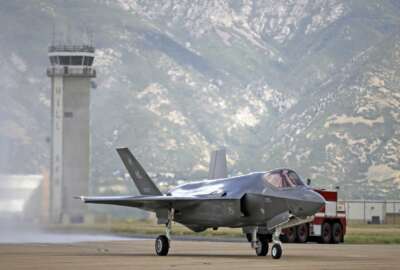
Despite growing list of problems, DoD says financial audit is already yielding benefits
David Norquist, the deputy secretary of Defense, said the nascent audit process -- expensive as it is -- is largely paying for itself already.
Best listening experience is on Chrome, Firefox or Safari. Subscribe to Federal Drive’s daily audio interviews on Apple Podcasts or PodcastOne.
The results of the first two years of Pentagon audits show that auditors are finding financial problems faster than the Defense Department is managing to solve them. Nonetheless, department leaders say they’re already seeing steady progress toward financial improvement, and that it’s likely that a majority of Defense organizations will earn clean audit opinions within the next five years.
The overall Pentagon audit is really a compilation of two dozen smaller audits — each for a different DoD organization or large pool of Defense funds. As of this year, just seven of those have earned clean opinions from auditors.
In testimony before the Senate Armed Services Committee Wednesday, David Norquist, the deputy secretary of Defense, was unwilling to hazard a prediction on how long it will take for the department as a whole to get a clean opinion on its overall financial statements. But he said going forward, the number of DoD organizations with clean opinions will likely rise at a rate of about one per year.

![]() “You’ll see different parts get to a clean opinion, you’ll see the number of problems going down, or you’ll see some where they have only a single issue holding them up,” he said. “That’s very helpful for focusing the audit. I don’t know how long it takes to get to the last one, because it’s really about who’s the slowest and takes the longest, and that will be the final pin to drop.”
“You’ll see different parts get to a clean opinion, you’ll see the number of problems going down, or you’ll see some where they have only a single issue holding them up,” he said. “That’s very helpful for focusing the audit. I don’t know how long it takes to get to the last one, because it’s really about who’s the slowest and takes the longest, and that will be the final pin to drop.”
Between DoD’s first two years of full-scale financial examinations, auditors have found more than 3,700 different accounting problems they deemed serious enough to warrant individual notices of findings and recommendations. So far, the military services and Defense agencies have only dealt with about 500 of those.
And the audit itself is an expensive exercise, costing DoD nearly $1 billion per year in both 2018 and 2019.
Last year, $195 million went to independent auditing firms, which supplied the bulk of the 1,300 personnel who examined the military’s ledgers and systems. The Pentagon estimates another $250 million in its own personnel and infrastructure costs went to support the audit, and it spent another $500 million to fix the problems auditors found.
But Norquist said to a large extent, those expenses are already paying for themselves.
He said the exercise has forced the military services and agencies to clean up their data, scrub their inventories and improve their systems — activities which have already pointed the way to hundreds of millions of dollars in savings.
“When you look at what the Defense Finance and Accounting Service spends to process our transactions, they have very good data over how much they spend fixing errors. Their costs will go down by at least $400 million when they start getting clean data,” he said. “When you look at the money that the Navy has saved — $167 million — when you look at the $316 million that the department was able to use data analytics to recover as we did our budget scrubs, that’s the cost of what we’re spending on the audit and than some. So in terms of paying the auditors, we’re already recovering that right now. We’re just living off the benefit of all of their findings, making sure the rest of the money we spend is better, that our processes get better, and that we bring discipline to the system.”
Range of noncompliance with accounting standards
Many of the Pentagon’s financial management problems are systemic. In the latest audit, DoD’s inspector general pointed to 25 material weaknesses in the department’s financial statements — five more than the previous year. They point to broad categories of noncompliance with accounting standards, like weaknesses in DoD’s oversight and monitoring of its spending, failures to assign funds to the proper accounts, and an inability to reconcile its account balances with the Treasury Department — the equivalent of balancing the department’s checkbook.
But Norquist said the audits have shown the department is faring fairly well in other areas. By and large, the department has been able to account for the existence and completeness of major pieces of military equipment.
Related Stories

DoD audit uncovers millions of dollars in unaccounted-for spare parts
“That’s incredibly valuable, and one of the things that I’ve heard when I talked to the auditors is the importance of the local leadership,” Norquist said. “When they show up and the commander of the base personally meets them and walks them around, they can quickly see they’re likely to have a good result because that leadership has control and oversight of the process. Now, we have other places where the samples are not there, so we have to get there on everyone, but this is going to get solved at the local level.”
And for installations that aren’t able to show 100% accuracy, the audit is forcing corrective actions, he said, partly because audit readiness is now a factor in performance evaluations for all senior military officers and members of the Senior Executive Service.
“The value of the audit is the auditors will come up every year and poke them for that problem and expose it, because the audit requires that if we have [a piece of property], it’s in our system and it’s properly recorded,” he said. “This is valuable for readiness. This is valuable for making sure we make the best use of taxpayer’s money. The value of the audit is the discipline. It’s not enough to clean out your office once. The auditors are coming next year, they’re coming the year after. You’ve got to make this a habit.”
And Norquist contends the early wins the department has seen in the area of property inventory has helped earn local uniformed leaders’ buy-in for the audit process.
At the Navy’s Fleet Logistics Center in Jacksonville, Fla., for instance, commanders got ready for the audit by conducting their own “exploratory assessment” of two aviation squadrons’ property holdings, comparing the actual items in warehouses against official records. They found $81 million in equipment that wasn’t recorded and used it to fill 174 property requisitions that had been backordered, and freed up 200,000 square feet of storage space.
“One of the concerns we had going in was that this would be seen as just a paperwork exercise, that this is just an admin drill. But the issue over inventory quickly turned around the views of the military that we dealt with to understand it wasn’t about paperwork, this was about readiness. This was about being able to do their mission,” Norquist said. “So I never ended up getting the pushback that I was afraid I was going to see. So I think we’ve seen a change. I think we’ve seen a level of emphasis that’s stronger in some places than others, but I think we’re going to continue to see it grow.”
But Norquist also cautioned that Congress’ habit of funding the department via continuing resolutions isn’t helping matters. That’s partly because delivering budgets well after a fiscal year has already started creates a huge time crunch for the acquisition and supply workforce, making it less likely that they’ll properly record the property DoD buys in its official accounting systems.
“So I ordered the inventory, but it’s a rush, because I didn’t get it in a normal sequence. So I put it on the shelf and I’ll get around to loading it into the inventory system later. Life gets busy,” he said. “Another part of this is that people doing the audit are the ones most effected by the CRs: the acquisition community and financial management workforce. All of these folks who are now spending their time over here, we want them over on the other side, getting the data and getting the process right. So it’s very disruptive.”
Copyright © 2025 Federal News Network. All rights reserved. This website is not intended for users located within the European Economic Area.
Jared Serbu is deputy editor of Federal News Network and reports on the Defense Department’s contracting, legislative, workforce and IT issues.
Follow @jserbuWFED





